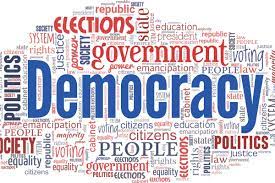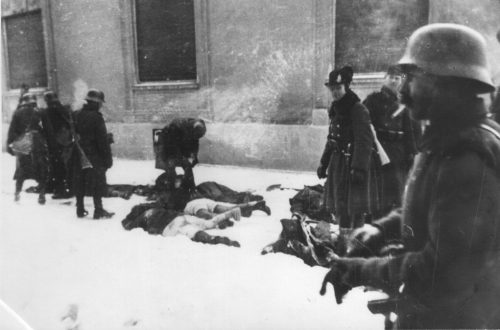By Jurek Molnar
One of the most amusing things in contemporary culture is Godwin’s law.
Wikipedia informs us: “Godwin’s law, short for Godwin’s law (or rule) of Nazi analogies, is an Internet adage asserting that as an online discussion grows longer (regardless of topic or scope), the probability of a comparison involving Nazis or Adolf Hitler approaches 1. In less mathematical terms, the longer the discussion, the more likely a Nazi comparison becomes, and with long enough discussions, it is a certainty.”
It seems obvious that most comparisons with Nazism or qualifications of something as Nazi like are either cheap political insults or lack an informed historical perspective. (Or both.) However, as uninterested observers, we do not care at this moment if any given opportunity is accurate or justified. We immediately recognize instead that the Nazi trope itself refers to a cultural horizon, in which for better or worse the Nazi regime, Hitler and the ideology of “Aryan supremacy” has become the ultimate villain. (Nazis were never “white supremacists”, because that is a specific trait of Anglo-French colonialism and 19th century American politics.) This leads to a contradictory situation, in which Nazi ideology is not in any objective category individuals locate themselves in, but the benchmark every political actor wants to distinguish him or herself and keep enough distance from. The paradoxes speak for themselves.
Nobody wants to be compared with Nazis, and even those who are suspected to be Nazis are usually rejecting it. If someone is smearing someone else as a “communist”, the reactions are of limited range. To get labelled as a “communist” is in some parts of society a career obstacle in others it is an advantage and it is usually (at least today) not a career ending process, while to be identified as a “Nazi” usually is. Again, it does not matter to us right now how much justification the fact itself deserves and we do not have to go into the many exceptions the statements above obviously contain. It is sufficient to take this as a general assumption and infer our conclusions from this point. The Nazi trope itself is a cultural artifact, which serves a function. And this function is to establish a point of negative absoluteness, from which political judgements can be drawn with certainty. Since nobody wants to be like the Nazis, Nazi ideology is simply something that nowadays can only exist outside socially accepted boundaries. In Western societies and mostly everywhere else, to use Nazi tropes and Nazi symbols is considered a breach of social norms. Actual contemporary Nazi supporters, who are proud members of _18 or _88 hashtags are quite rare and nowhere in civilized countries do actual Nazis have any prospects of winning elections or changing politics, let alone stage a coup. In my own country, Austria, to promote Nazism, displaying Nazi symbols in public, to deny the Holocaust or to sell “Mein Kampf” in regular bookshops is simply outlawed and will be met with criminal prosecution by authorities. And while all of us can agree that this is a good thing, as uninterested observers we are mainly concerned with facts, which will provide us with reliable arguments. The practical absence of any political movement that copies, emulates or mimics traditional Nazi ideology is a visible and agreed fact. Nevertheless, the past and images of the past keep haunting us. Regular judgments on the absolute negative character of Nazism change concerning the environments of current intellectual struggles and in regard to arbitrary political objectives. One particular judgment is the idea that the historical National Socialists were politically speaking more socialist than national.
In a recent part of a comment section on HP, the idea that the historical Nazis were most of all socialists appeared in an interview with philosopher Stephen Hicks, who actually did not say that Nazis were socialists, but focused instead on the term “collectivism”, which he attributed to Nazis and communists alike. Hicks is a serious philosopher and historian of philosophy, whose arguments are not at all trivial. He has done some interesting work like “Nietzsche and the Nazis” (2010) or “Explaining Postmodernism” (2013), which established him as a modern liberal thinker and critic of progressive thought. Hicks and his ideas, nevertheless, are not of great interest for us here. The best way to tackle questions of this kind is to emphasize reliable and accurate history. We will focus on the main question: How socialist were the National socialists actually? And we will assume here that the word “socialist” is a synonym for “being left”, so it is possible to extend the question: Were the Nazis actually left wingers? I want to answer both questions separately. For the sake of the argument, let us try to find an explanation for the latter one first.
If one tries to think through the meaning of the question “Were Nazis left-wing?” it is quite obvious that the sentence does not mean much. Left and right are not at all objective terms, they only make sense in relation to each other and this relation changes throughout history and geographic location dramatically. The question then splits up into two other questions: Did the Nazis perceive themselves as left? Did any of their political opponents ever perceive them as left?
No matter how deep we dig into these questions, “left” and “right” remain very arbitrary descriptions of incomplete nature. If the Nazis were politically on the left, then arguments about Stalin and his Soviet Union being politically right wing should also be valid. The confusion such arguments create, usually produces answers, in which the meaning of the terms “left” or “right” is going into complete disarray and eventually leads us even further down the rabbit hole. The short answer to the question “Were the Nazis actually left?” is: The question itself would have never occurred to anyone.
The main fallacy of the idea that the Nazis were left is that nobody at the time inside or outside Germany would have confused the Nazis with a left wing organization. The reason for this has very little to do with ideological imperatives and it is completely unrelated to individual opinions that may or may not have been common among party members of the NSDAP at any given time. The major rift in the Weimar Republic of Germany between 1918 and 1933, the poles that defined left and right in this particular historical time and space was the perspective on the end of WWI.
At the end of 1918, the German Emperor Wilhelm II resigned or was forced to resign from his throne pressured by parts of the established elites and Germany became a Republic, the first completely democratic state on German soil. In hindsight, it was doomed from the beginning. Reparation demands became a heavy burden on its economy, disappointment about corruption and nepotism started soon to dominate public opinion and the building of institutions, which could establish accepted laws and structures of political consent, turned into a nightmare. The Weimar Republic was constantly in a state of anarchy and chaos, in which gangs of armed violent thugs met each other in battles on the street, some authorized by state factions others against them, terrorizing the populations of whole cities. All these turmoils arose from the conflict when old elites and new elites fought for domination, thereby unbalancing the fragile nature of a state already failing, tearing each other apart about who was to blame for the catastrophic result of the Great War, the hard realities of an economic crisis and in particular the lack of public order.
The German defeat in WWI created two competing narratives. The first one, mostly promoted by Social Democrats, Communists and the relatively small liberal bourgeoisie, artists and intellectuals, was that the defeat of the German Reich and the abandonment of the monarchy were necessary preconditions for social progress and in radical language the main catalyst of socialist revolution, which had already been expected to happen decades ago. Remember that Lenin and Trotsky had to break with an old Marxist doctrine, which predicted the revolutions of the working classes in the developed countries first. The disappointment about the hesitancy of German working class movements reached a peak, when German Social Democrats supported the bill that enabled the German Kaiser to start WWI. Lenin then had to invent the theory that the chain breaks at its weakest point, which fortunately for him turned out to be Czarist Russia.
The competing backstory followed a very different pattern and became famous as the stab-in-the-back myth (Dolchstoßlegende). According to this narrative, the German army was not defeated on the battlefield. The conservative and reactionary German elites were overwhelmingly convinced that their war strategy in 1918 had begun to gain momentum and was very short of turning around the tides. However, a conspiracy of Social Democrats, Liberals and Jews transformed the success of German weapons into a humiliating surrender in the halls of Versailles. This interpretation was widely accepted by many WWI veterans, the entire Prussian nobility, most of the conservative bourgeoisie, all right wing militias, and last not least the upcoming fraction of National Socialists. Remember that Hitler tried to perform a coup in 1923, which failed. The thugs he commanded were nearly all WWI veterans or members of paramilitary organizations, mostly illegal militias, who shared the same hatred against the Weimar Republic and its institutions. They were all in for the stab-in-the-back reprisal. It is remarkable, thereby, that Hitler actually came to power by a democratic process and not a military insurgency, which he certainly had preferred. (Not so much different from Lenin, by the way.)
This major rift, the perspective on German defeat in WWI became the dominant pattern, which defined the left and the right and the Nazis were from start to finish quite distinctively right-wingers of the most extreme kind. There can be no doubt about that. While anti-Semitic attitudes played a big role among all factions of the Weimar Republic, the anti-Semitism of the Nazis became very soon their trademark in terms of political campaigning. The Jew hatred of the Nazis was the most vicious in a very strong competition. It distinguished them even from other right wing groups and the hatred grew directly from the dark side of German intellectual life, which suffered from the fact that Germany had become a united nation only very late in history. There are nevertheless very good arguments that locate the ideological origins of Nazism in the spectrum of socialist and hence left wing agendas of the early 20th century. One can check out references to Hitler’s mentor in the German Workers Party of 1919, Anton Drexler, who started out as a socialist revolutionary, but became just another disturbed anti-Semitic ghoul. However, the ideological tools the Nazis used were outplayed by their actual political behavior inside the given constraints of Weimar politics and this behavior located them on the right. So, the Nazis were not left, if that term has to contain any meaning at all.
Which brings us to the question, whether the National Socialists were actually socialists?
This one is quite hard to answer and not entirely a one-way street. For a start, Nazism was a working class movement. Left wing historians and Marxist intellectuals to this day have great difficulties swallowing that fact. The earliest Communist doctrine of fascism, Georgi Dimitrov’s famous depiction of fascism as the political form the most reactionary forces of capital and industry prefer, focused primarily on the defamation of Social Democrats as supporters of fascism. It never addressed the problem that communists and Nazis advertised for the exact same audience. As a working class movement, Nazism was naturally exposed to all sorts of socialist ideas and influences. In a country that was impoverished, economically weak and veterans as much as their families suffered from trauma and loss, this was not at all surprising. The Nazis shared with conservative bourgeoisie and the Prussian nobility a certain narrative about the Great War, the establishment of public order and the role of Germany in the orchestra of European powers. But they also shared with communists the same idea of mass organization and had to address similar or even the same social issues to appeal to these masses. Nazism, just like Mussolini’s fascist Italy, was the compromise between the requirements of two mutually exclusive political programmes. As it turns out the great promise of fascism all over the place was always to reconcile class struggle with a stable political order. Effectively this is the best definition of fascism available. Hitler offered the German people a solution, which disguised the conflict by using a monstrous propaganda machine and resorted to extreme violence, when the conflict could not be hidden under the rug any more. Once everybody had boarded the ship, there was no going back.
The early versions of the NSDAP party programs contained all sorts of socialist and revolutionary demands, from higher taxes to expropriation of land owners, but this changed when industry and capital started to fund Hitler. The ranks of the early NSDAP consisted mostly of veterans, who came from humble origins. There were no nobles, bourgeoisie or progressive intellectuals among them. The Nazis represented people from Plebeian upbringings, who fostered an ideology, which originated from the old Patrician elites. This contradiction dominated the Nazi state throughout its short life. Bolsheviks would have never tolerated the Romanovs to be part of their system of government, but the Nazis got along quite well with the Hohenzollerns. Communists in power have destroyed the old elites in order to create new ones, but the Nazis had to integrate new elites in accordance with old ones, something that they accomplished for a quite a while by promoting Hitler as the Aryan messiah and transforming antisemitism into a monitoring instance to create conformist behavior.
The Prussian nobility assembled in paramilitary organizations, which considered the early National Socialists as foot soldiers of their own cause at best or as another plebeian insurgency at worst. Before 1933 the old conservative bourgeoisie, the elites of industry and the Prussian nobles tried to manipulate the Nazi movement in order to use it as a tool against Social Democrats, Communists and unions alike. Little did they know who manipulated whom. Socialism, for Hitler, was a word he could use to frighten his donors or to threaten them into obedience. And as far as we know he used the word tactically, very efficiently.
The Nazis competed with Communists and Social Democrats for workers’ votes, but everyone involved, including the workers who voted, were absolutely aware who was on the right and who was on the left. Communists wanted the votes for achieving power, Nazis wanted the votes for achieving legitimacy. It was obvious for all who paid attention that Hitler had good relationships with major figures of industry and capital for exactly that reason, and the NSDAP had rich donors like Hugenberg, who owned a press which advertised Hitler and the party doctrines. While communists believe that masses are power, which the revolutionary vanguards distribute, Nazis believed that power comes through the masses but is not meant for them. Consequently, power for them was equal to establishing an enduring order, while communists almost naturally tend to the destruction of order in repeating cycles.
The “socialist” part did play a role though, since Hitler promised the masses a socialism for all (Aryan) Germans, but nobody at the time had any difficulty to spot the difference between communist socialism and National Socialism. Communists think that socialism applies to everyone. National Socialists think that socialism applies to everyone who is considered a human aka Aryan German. That difference is crucial. While communists are an offspring of 18th century Enlightenment, German conservatives and reactionaries, who were the backbone of Nazi intelligentsia, hated the Enlightenment of French and English origins bitterly. The “national” part in National Socialism did not refer to national borders, but was a hint that these socialists were anti-Semites, who wanted a national socialism against an international – Jewish – socialism. Even when one tries to apply Hicks notion of “collectivism” as a more abstract concept, it does not really turn out to be accurate. Communist collectivism was about a collective of people, imprisoned in conformist unity. Nazi collectivism was much less about people, but referred to an 18th century romantic idea of a “German spirit”. While the Soviet Union was all about materialism, the Nazis thrived desperately to be idealists. Overall, there is not as much socialism in National Socialism as one would expect, but on the other hand, there is also not so much “nationalism” in National Socialism either. The absurd ambivalence around all this just demonstrates how little such words really mean, if one searches for historical truth and accuracy. Our observations must end here.
Every Uninterested Observer is completely aware that similar properties do not constitute identity. And while the historical judgment on everything that is related to Nazism is final and needs no further qualification, let’s also be clear that no one ever escapes Godwin’s law.



